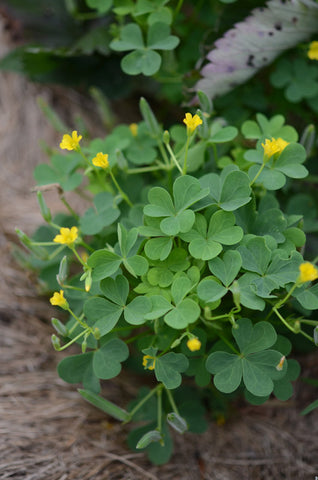My friend Gretchen pulled a pinch of wood sorrel (pictured below) from the forest floor, and popped it into her mouth. "What are you doing?" I asked. She held out a few tender pieces between her fingers. "Wood sorrel, try it." she said.
There was a burst of flavor - it tasted like the skin of a ripe concord grape, mixed with lemon. I couldn't believe something that small could hold so much flavor. Now I eat it whenever I find it in a safe place. Safe as in: a yard without dogs (because pee) or around sidewalks (because pee).

My son and I are pretty passionate about sharing this secret with others. (Thank you Gretchen!) Oh the frustration we feel when someone is too chicken to try it!
Microgreens are often touted as a health food, but it overshadows the avalanche of flavor. Unlike most lettuces, which tend to be mild, they can be spicy, herbal, peppery (like arugula), lemony or earthy. I frequently buy spicy microgreens at the farmers market, since grocery stores tend to be late to the game. Sprinkled upon a salad, scrambled eggs, sandwiches, grilled fish or tacos, they add another level to everything they touch.

Below is a quick guide of the type of microgreens to look for when shopping, whether at a farmer's market, online, or a health food store. If you're lucky, maybe you'll find a major chain that isn't late to the party.
Peppery microgreens
- Nastrurtium (pictured above - it also makes a beautiful plant!)
- Arugula
- Red "Rambo" radish
- Garden cress
Lemony microgreens
- Wood sorrel (grows wild everywhere!)
- Lemon basil
- Red-veined sorrel
- Lemon balm
- Gem marigold

Herbal microgreens
- Dill (yes, that dill - fresh sprigs beat the dried spice any day!)
- Monogerm cilantro
- Anise hyssop
- Red Rubin basil
Earthy microgreens
- Alfalfa sprouts (with hummus on whole wheat ...just sayin')
- Sunflower
- Broccoli sprouts
- Curly Kale
- Bull's blood beet


Comments (0)
Back to L & L Blog By: Fayeruz Regan